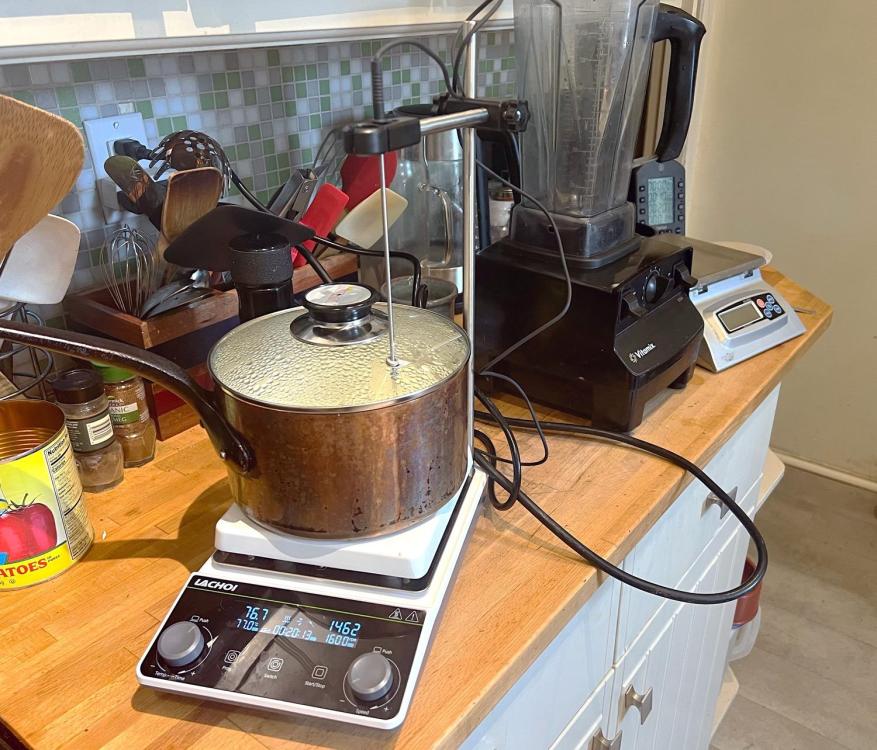-
Posts
5,169 -
Joined
-
Last visited
Content Type
Profiles
Forums
Store
Help Articles
Everything posted by paulraphael
-
The thing is, the berries weren't bitter on their own. The ice cream mix wasn't bitter in the hour after the berries were added. The bitterness showed up the next day in the finished ice cream.
-
Or to punish children.
-
Here's a head scratcher. Hoping someone with fruit science background has an idea. I made a batch of strawberry ice cream to test a recipe. Calculated for 300g strawberries / 1000g mix. I was about 45g short on strawberries, so made up the difference with raspberries. Both kinds of berries were medium-quality ... from Whole Foods, pretty ripe, pretty fresh, tasted fine but unremarkable. Berries were added to the mix after pasteurization and homogenization. I washed, cored, thickly sliced, and froze them. Then blitzed them into the freshly homogenized mix with a vitamix for 30 seconds. Idea was to use the berries to start the mix cooling, and do so without cooking the flavor out of the berries. I chilled the mix down to about 13°C in an ice bath. At this point, my girlfriend and I both tasted it and thought it tasted good. LIke strawberries. My only concern was textural; the viscosity was higher than normal. I refrigerated it down to 0.5°C overnight, and spun it today. It hasn't hardened yet. We both tasted it right out of the machine and almost had to spit it out. It's like when you try to hide a crushed pill in the cat food, but all you do is make the whole meal too bitter for the cat, and he's pretty sure you're trying to kill him. I've never experienced this before. Something introduced seriously bitter compounds into this brew while it chilled overnight. ChatGPT thinks it could be polyphenol oxidase reactions, which I would have inadvertently allowed by keeping the berries out of the pasteurizing step. It also suggests that there can be polyphenol oxidase reactions that are affected by milk proteins. I'd never heard of this (or anything) turning berries into bad medicine overnight. Thoughts?
-
I had to retire mine, because it drifted too much, and Xrite's calibration fee was rather insane. Mine has the Greytag-Macbeth branding, so is probably quite a bit older than yours. After some research I settled on a Calibrite Color Checker Display Pro. As a colorimeter it has some advantages over a spectrophotometer (more accurate in shadow areas, much cheaper) and a big disadvantage (can't calibrate printers). I don't like the industrial design as much as the i1's. But so far it works well in an art photography printing workflow.
-
Teo, 5 years later I've finally had a chance to experiment with this method. It's excellent—the best of the many methods I've tried. It succeeds at getting that fresh herbal flavor, without any of the grassy, woody, or vegetal overtones that come with the more common methods. A friend dropped off bushels of herbs from her garden, so I've been experimenting. The spearmint flavor is perfect, with 18g leaves / 1000g base. I skipped the peppermint because it lacked flavor. Anyway, thanks for the excellent tip. I haven't encountered this method elsewhere.
-
Most of these kettles sold in the US are 1500 watts, so they'll mostly boil water in the same amount of time. We had one that a couple of hundred watts more powerful, and you noticed the difference. It broke for unrelated reasons. Manufacturers avoid doing this, because if you plug them into a 15 amp circuit, and use just about anything else on the same circuit, the breaker trips. In other parts of the world the wiring standards give a higher ceiling for powerful gadgets.
-
-
It would be cool if you vacuum seal in bags that have a release valve for CO2. This is what my roaster uses. I don't actually know how big a difference it makes ... but seems like a good idea.
-
I've never noticed any degradation from freezing. The important point is that freezing is for bulk storage, not for the beans you're using every day. The beans you freeze should be sealed, frozen, and then allowed to come up to room temp before unsealing. And then they stay at room temp for however many days it takes you to use them. This eliminates the one problem with frozen beans—that they take on moisture from condensation every time you open the cold bag. This is pretty standard practice in the 3rd wave coffee world. The only pushback I ever got was from someone who was trained at Starbucks and thought he was an expert. I do think people need to reconsider what fresh means in coffee beans, especially now that we have higher quality beans and roasts available. I used to assume that fresher is better. Now that I'm mostly buying lightly roasted single-origin beans, I can say with certainty that this isn't the case. Beans like this that are too fresh off the roast give poor results. You get huge blooms of CO2, which lends a carbonic acid acridity to the coffee, and interferes with the aromatic flavors. For brewed coffee, results seem ideal between 5 days maybe 14 days after roasting (I'm not talking about freezing here ... just room temperature storage in a sealed back, preferably one with a relief valve). For espresso, it's more like 7 to 20 days. Espresso is more sensitive to CO2. The darker the roast, the sooner the coffee will be ready to brew and the sooner it will lose quality. Degree of roast corresponds with increased porosity of the beans ... darker ones lose CO2 faster, and take on oxygen faster.
-

Health risks from room temperature tea set out all day?
paulraphael replied to a topic in Coffee & Tea
Exactly. And the food service industry needs to be paranoid about immune-compromised diners. And in the industry, the math is very different. If you read that in the US, 1 egg in 20,000 is tainted with salmonella, that might be close enough to zero for your purposes. If you're running a chain of restaurants that serve brunch to 2000 people every weekend, that number starts to sound like a problem. I think it's a good reminder for anyone who's got an immune-compromised person at home. I personally drink tea that's been sitting out all night pretty regularly. I've seen it get moldy over the course of a weekend (trying not to make a habit of that). The good news from the article is point #1: there's no record yet of tea being a problem. -
Is this true? I just jumped through so many hoops to find a lid to fit my 2.5L Mauviel saucepan. Do you have a good source for metric commercial pan lids?
-
I asked Cargill, the overlords that make DC salt, how to be sure I'm getting the actual kosher salt and not the new imposter version. They write: We have updated our packaging but the product inside the box has not changed. We are really excited about our new brand Diamond Crystal Salt Co. and the new look for our favorite Diamond Crystal Kosher salt packaging. So, we are all imagining that there's anything wrong with our salt, and furthermore, we should all be really excited about the new packaging. Move along, folks. Nothing to see here.
-
Mine have that little raised line also. I'll take a closer look at my pan. Surprising that teflon could ever scratch steel.
-
I was worried about this, but the stirrers I'm using don't leave any marks. They're standard lab things, shape like pills and covered with teflon. What were you using?
-
After a couple of years of shopping and foot-dragging, I got a lab hotplate with magnetic stirrer. The main use will be pasteurizing ice cream, which for various reasons I like to do at a moderate temperature for a long time (usually 30 minutes). I've been doing this sous-vide for many years now, which is imperfect; there's no simple way to know the actual temperature of a blob of thick liquid in a bag. It's also a little cumbersome, and you waste a lot of plastic. I do like that a sous-vide bag is sealed, to keep in any aromatics. The most challenging part of moving to a hot plate was finding a lid. My old stainless-lined copper saucepan is a perfect vessel—non magnetic, so it will let the stirring rod spin. But my only lid for it is an ancient Calphalon one, which I don't want to drill for the temperature probe, and which i can't find any more of online. These French copper pans are non-standard sizes. And I'm not getting a 2nd mortgage to buy a Mauviel copper lid, just to drill a hole in it. Restaurant supply store to the rescue. I brought my measurements and a tape, and just dug through everything. This Chinese glass lid was so close I was afraid it would be too tight. It actually fits like it was made for the pan. It has a little metal-rimmed vent hole that's exactly the right size for the probe. Score! Only $10. The lab hotplate works well. It's a cheap Chinese model that cost $180 on Amazon (the serious ones that they use in serious labs cost many times this). It feels solidly built and all the controls are intuitive (except for the programming features, which I'll pretend don't exist). The only shortcoming is the power. It's not listed anywhere but I'm guessing it's just a few hundred watts. Great for holding a big pot of stuff at temperature, but too weak to get it there in a reasonable time. So I start out on the stove on high heat and move to the hotplate when it gets within a degree or so. The stirring motor / magnet is also not very powerful. It struggles to get a strong vortex in 1kg of ice cream mix. This may be because I've been using supermarket cream that has added gums—my mixes have been more viscous than usual. When I get a better source this may stop being a problem. Nevertheless, the company says this hotplate has a 5 liter capacity, which seems hugely optimistic. It's adequate for my purposes. I'm also looking forward to keeping things warm with it at dinner parties. [Edited to add:] This thing is forcing me to be disciplined about adding a straining step. I really don't want to serve—or blend—a magnetic stirring rod.
-
It looks like a cool idea. How powerful is it? What's the stirring mechanism you're proposing? I just bought one of these, at the upper end of the price range you mention. On the plus side, it has a magnetic stirrer, which is important for my purposes (pasteurizing ice cream). It lets it cook with no chance of scorching or unevenness, and minimal evaporation. And it's very precise. On the minus side, it's probably not repairable, and it's underpowered. Wattage isn't listed anywhere, but I'm guessing it's around 200W or so. I bring a pot up to temperature on the stove and use the hot plate to hold it for 30 minutes or so.
-
That looks great. Would you consider it a sherbet, since it's got milk? Is cultured skim milk a common product in your corner of the world? I haven't encountered it. And what does "hot" signify in the inulin?
-
I wrote to Diamond Crystal, and while they refused to acknowledge that they've lost their marbles, they did send me a coupon for a free box of salt. Just have to remember which one to look for.
-
6:11 is right, if you can be sure the mix is that hot all the way through. If you're doing anything commercial, you still need to check with the local health whoevers. The rules aren't always based on the best science. There are benefits besides safety to holding at temperature longer, or also using a higher temperature. To get the milk proteins working for you.
-
I looked at those, but they seem like they'd be harder to clean out and would lead to more waste. With a beaker or pan, you can easily scrape out the sides with a spatula. Ice cream is pretty viscous.
-
Interesting that you're getting so much overrun that it's filling up the bowl. My experience is with the old version of the attachment, but I assume the size is similar. I typically got about 20% overrun, sometimes a little more. Nothing that would fill the bowl. Are you getting that volume with the polysorbate 80? Also, is there such thing as a lid / stopper for a beaker like that, preferable already with a hole for a temperature probe? I only see them for thin-necked flasks.
-
They do have one machine with a fairly powerful compressor (might only be sold by Williams Sonoma ... it's the one with the metal dasher). Its performance is going to be held back by the removable bowl. And I'm pretty sure that all the Whynter machines have a warranty that's voided if you use them commercially, which is one clue (I checked this when looking for all the semi-pro options). Probably a nice machine, but getting into the Musso price range.
-
I've been using the Nemox Gelato Chef 5L for a couple of weeks now. A few batches, a few measurements. Just wrote an initial review. TL;DR: I'm keeping it!
-
I've tried it both ways and didn't get any salt or alcohol in the ice cream. But it may not matter ... I'm guessing I'll use it just with the fixed bowl. One advantage of alcohol is there's no real added cleanup. Just wipe it out and let it evaporate. Brine needs to be cleaned completely because of corrosion risk. But alcohol does add about 50 cents worth of cheap vodka to the cost of every batch.
-
It's got a fixed and removable bowl. Your choice. The removable one fits inside the fixed one, with a couple of ounces of conductive liquid poured in first (brine or alcohol). The stainless dasher has interchangeable plastic scraper blades; you swap blades when switching bowls, so the dasher always makes solid contact with the bowl. My first 2 batches were with the removable bowl; I think the performance compromises may not be worth any added convenience. I'll try the fixed bowl next. It typically goes for $2K. The distributor generously gave it to me for wholesale cost. These machines have little exposure in the US, and I told them I planned to write about it. Based on research, I'd probably have still bought bought at full price. But maybe not right now, and definitely not as cheerfully. I'll have much more to add after putting it to work a few more times.









